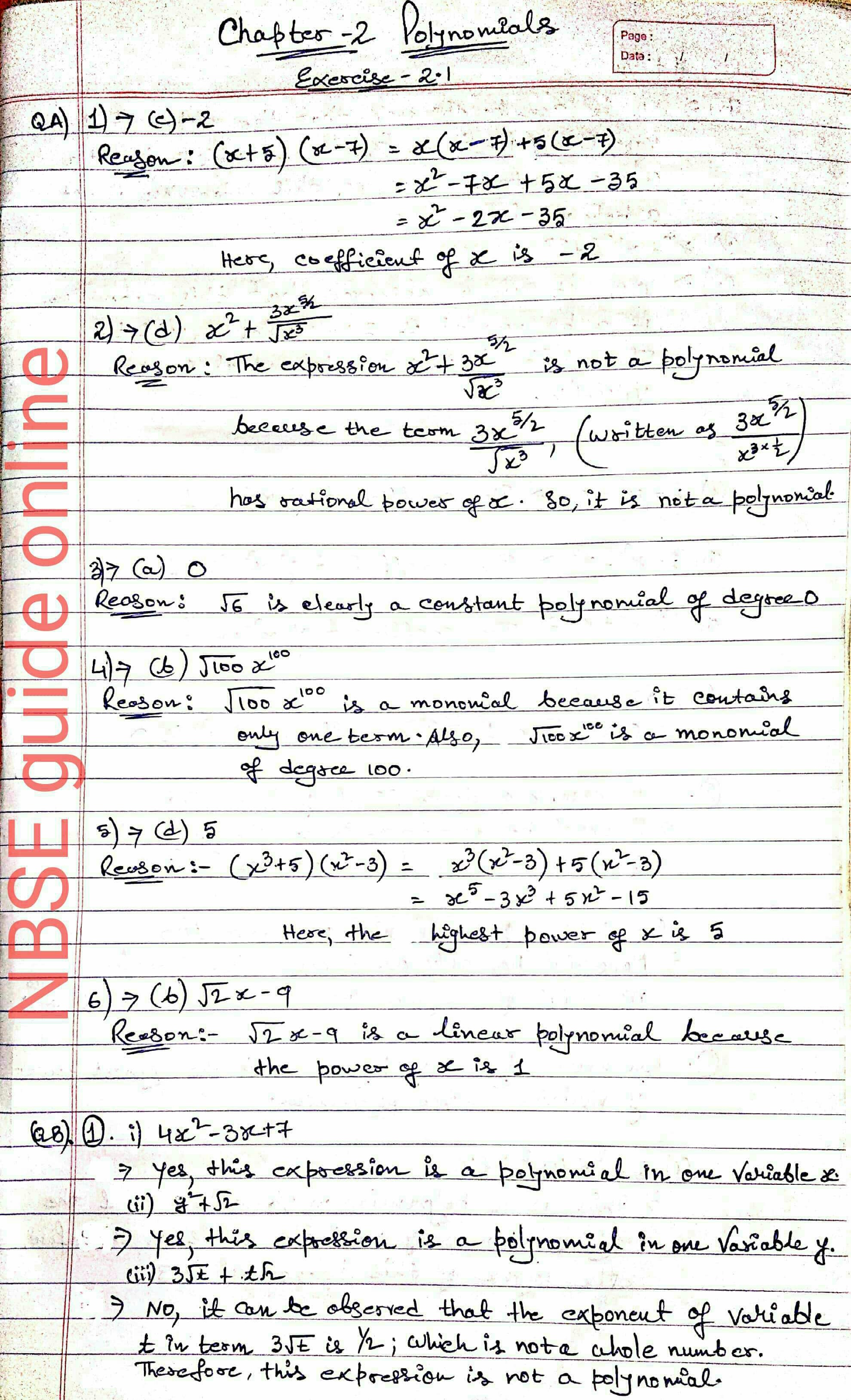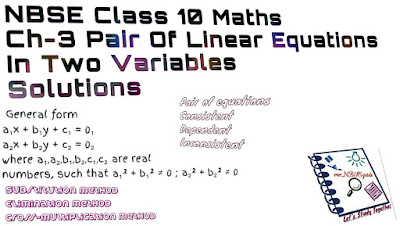Class-10 : Maths - Chapter : 4 Quadratic Equations (Ex-4.1 Ex-4.2 Ex-4.3 Ex-4.4)
QUADRATIC EQUATIONS
In this chapter, students will get to know the standard form of writing a quadratic equation. The chapter goes on to explain the method of solving the quadratic equation through the factorization method and completing the square method. The chapter ends with the topic on finding the nature of roots.
To download Ch-4 (Quadratic Equations) solutions in PDF please click on the link below :
Ex - 4.1 : Download PDF
Ex - 4.2 : Download PDF
Ex - 4.3 : Download PDF
Ex - 4.4 : Download PDF
Note : All the copyright of this PDF content belongs to NBSEguideonline. It is available to all NBSEguideonline users without any subscription.
Points To Remember
QUADRATIC EQUATIONS
The polynomial of degree two is called quadratic polynomial and equation corresponding to a
quadratic polynomial P(x) is called a quadratic equation in variable x.
Thus, P(x) = ax² + bx + c = 0, a ≠ 0, a, b, c ∈ R is known as the standard form of quadratic
equation.
There are two types of quadratic equation.
(i) Complete quadratic equation : The equation ax² + bx + c = 0 where a ≠ 0, b ≠ 0,c ≠ 0
(ii) Pure quadratic equation : An equation in the form of ax² = 0, a ≠ 0, b = 0, c = 0
ZERO OF A QUADRATIC POLYNOMIAL
The value of x for which the polynomial becomes zero is called zero of a polynomial
For instance,
1 is zero of the polynomial x² - 2x + 1 because it become zero at x = 1.
SOLUTION OF A QUADRATIC EQUATION BY FACTORISATION
A real number x is called a root of the quadratic equation ax² + bx + c = 0, a 0 if aα² + bα + c = 0. In this case, we say x = α is a solution of the quadratic equation.
NOTE:
1. The zeroes of the quadratic polynomial ax² + bx + c and the roots of the quadratic equation ax² + bx + c = 0 are the same.
2. Roots of quadratic equation ax² + bx + c = 0 can be found by factorizing it into two linear factors and equating each factor to zero.
SOLUTION OF A QUADRATIC EQUATION BY COMPLETING THE SQUARE
By adding and subtracting a suitable constant, we club the x² and x terms in the quadratic
equation so that they become complete square, and solve for x.
In fact, we can convert any quadratic equation to the form (x + a)² - b² = 0 and then we can
easily find its roots.
DISCRIMINANT
The expression (b² - 4ac) is called the discriminant of the quadratic equation.
SOLUTION OF A QUADRATIC EQUATION BY DISCRIMINANT METHOD
Let quadratic equation is ax² + bx + c = 0
Step 1. Find D = (b² - 4ac)
Step 2.
(i) If D > 0, roots are given by x = (-b + √D) / 2a , (-b – √D) / 2a
(ii) If D = 0 equation has equal roots and root is given by x = -b / 2a.
(iii) If D < 0, equation has no real roots.
ROOTS OF THE QUADRATIC EQUATION
Let the quadratic equation be ax² + bx + c = 0 (a ≠ 0).
Thus, if (b² - 4ac) ≥ 0, then the roots of the quadratic
—b ± √(b² — 4ac)/ 2a equation are given by QUADRATIC FORMULA
—b ± √(b² — 4ac) / 2a is known as the quadratic formula which is useful for finding the roots of a quadratic equation.
NATURE OF ROOTS
(i) If b² — 4ac > 0, then the roots are real and distinct.
(ii) If b² — 4ac = 0, the roots are real and equal or coincident.
(iii) If b² — 4ac <0, the roots are not real (imaginary roots)
FORMATION OF QUADRATIC EQUATION WHEN TWO ROOTS ARE GIVEN
If α and β are two roots of equation then the required quadratic equation can be formed as x² — (α + β)x + αβ =0
NOTE :
Let α and β be two roots of the quadratic equation (ax² + bx + c = 0) then
Sum of Roots : = – the coefficient of x / the coefficient t of x²
⇒ α + β = – b / a
Product of Roots : = constant term / the coefficient of x²
⇒ αβ = c / a
METHOD OF SOLVING WORD PROBLEMS
Step 1: Translating the word problem in to Mathematics form (symbolic form) according to the given condition
Step 2 : Form the word problem into Quadratic equations and solve them.
*****
NBSE Solutions for Class 10 Maths for all Chapters by NBSE Guide Online are provided here. Just click on the chapter wise links given below :
• Chapter 6 Triangles
• Chapter 7 Coordinate Geometry
• Chapter 8 Introduction to Trigonometry
• Chapter 9 Some Applications of Trigonometry
• Chapter 10 Circles
• Chapter 11 Constructions
• Chapter 12 Areas Related to Circles
• Chapter 13 Surface Areas and Volumes
• Chapter 14 Statistics
• Chapter 15 Probability
The solution list comprises all the chapter-wise answers to the questions present in the NBSE book for Class 10 in a very precise and lucid manner, maintaining the objective of textbooks.
*****
| Related Links |
| NBSE Class 10 Book-Keeping & Accountancy notes |
| NBSE Class 9 Book-keeping & Accountancy notes |
| NBSE Class 9 Mathematics Solutions |










Comments
Post a Comment
If you have any doubts please let me know